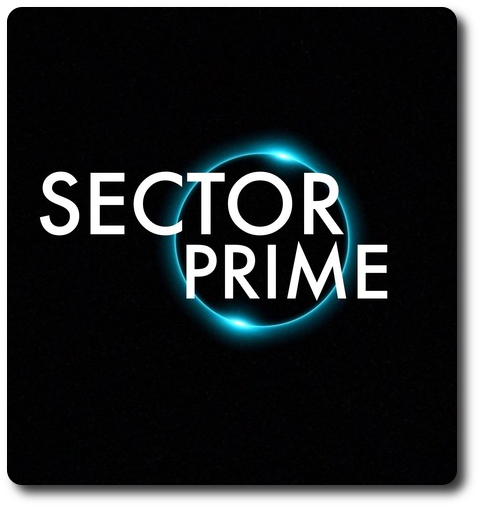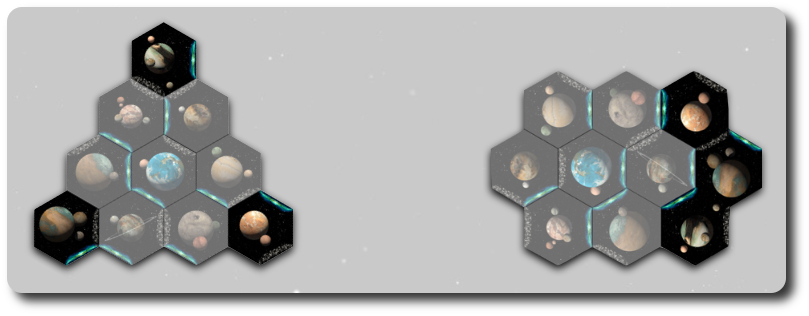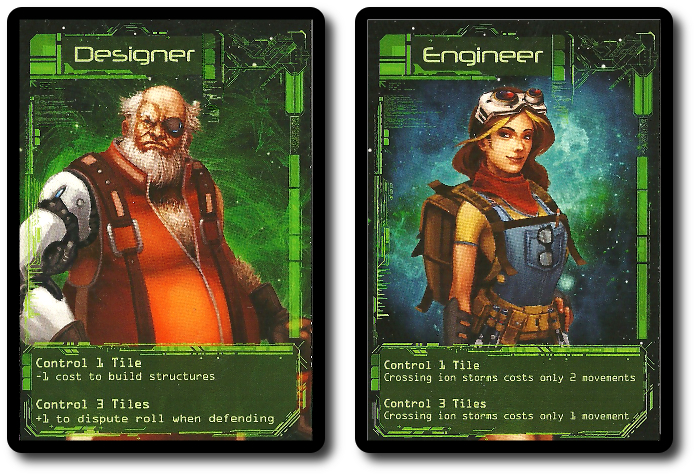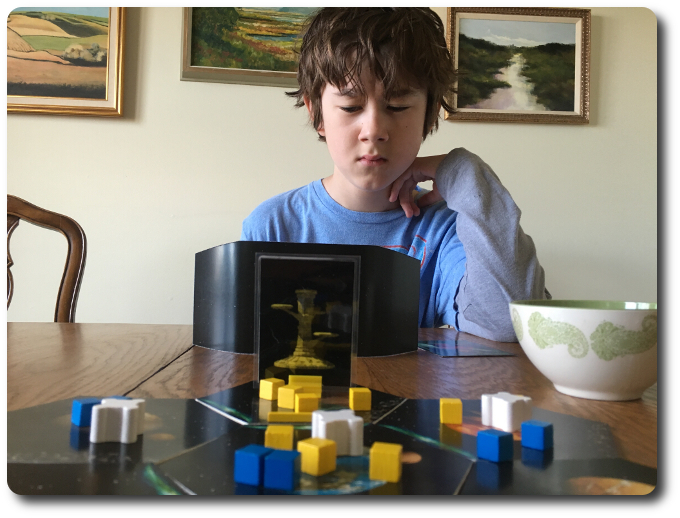Please Take Note: This is a review of the final game, but it might change slightly based on the success of the Kickstarter campaign. The game is being reviewed on the components and the rules provided with the understanding that “what you see is not what you might get” when the game is published. If you like what you read and want to learn more, we encourage you to visit the publisher’s website or visit the Kickstarter campaign. Now that we have all that disclaimer junk out of the way, on with the review.

The Basics:
- For ages 8 and up (publisher suggests 13+)
- For 2 to 4 players
- Approximately 45 minutes to complete
Geek Skills:
- Active Listening & Communication
- Counting & Math
- Logical & Critical Decision Making
- Reading
- Strategy & Tactics
- Risk vs. Reward
- Hand/Resource Management
- Worker Placement & Area Control
Learning Curve:
- Child – Easy
- Adult – Easy
Theme & Narrative:
- Mine the riches of space and slap the hands of those who try to take it from you
Endorsements:
- Gamer Geek mixed!
- Parent Geek approved!
- Child Geek approved!
Overview
What drives us to explore space? For some, it’s the yearning to learn more about ourselves. For others, it’s a chance to escape. For you, it’s about making money. A new Gold Rush is on, with massive robotic refiners and battle-ready mining drones doing the work of men. The competition is fierce and the stakes are high. Greed is a powerful motivator.
Sector Prime, designed by Scott Freedlun and to be published by Two Guys and a Giant, will reportedly be comprised of 4 Player screens, 6 Character cards, 100 Traxium Crystals, 8 Refineries, 13 Planet tiles, 16 Station cards (4 sets comprised of 4 cards each), 4 Station card holders, 4 standard eight-sided dice, 4 standard ten-sided dice, 5 standard twelve-sided dice, 4 Fabricator tokens, 12 Force Field/Jump Bridge pieces (4 sets of 3 pieces each), and 100 Drone tokens (4 sets of 25 tokens each). As this is a review of a prepublished game, I cannot comment on the component quality. In addition, the components listed here are noted as part of the base edition of the game, suggesting that updates are certainly on the way.
Welcome to the Sector
To set up the game, first allow each player to select 1 of the 4 colors represented in the game and then give them 25 Drone tokens, 1 Fabricator token, 3 Force Field/Jump Bridge pieces, 1 twelve-sided die, 1 ten-sided die, 1 eight-sided die, 1 Station Holder piece, and 4 Station cards of their selected color. In addition, give each player 2 Refineries, 3 Traxium Crystals, and 1 Player screen.
Second, place any remaining Traxium Crystals in a pile to one side of the game playing area. I suggest you use a small cup or bowl to help keep your playing area organized. At this time, place the “Algorithm” twelve-sided die next to the Traxium Crystals.
Third, shuffle the Planet tiles and randomly select a determined number based on the number of players. For a 2-player game, 7 Planet tiles are used. For a 3-player game, 10 Planet tiles are used. For a 4-player game, 13 Planet tiles are used. Place any Planet tiles not selected back in the game box.

Two examples of how a 3-player board game area can be set up
Fourth, 7 of the Planet tiles are then randomly placed to create a set pattern. Any remaining Planet tiles can then be placed face-up to the initial pattern in any location the players’ like as long as the tiles are adjacent to each other.
Fifth, determine which player will be the First Player and then shuffle the Character cards. Deal 1 Character card to each player, face-down. Players should look at their Character card, but not reveal it at this time.
Sixth, starting with the First Player and continuing in turn order sequence, each player will now select a Planet tile and place their “Base” Station card (with holder) and 3 Drone tokens. The stations can only be placed on the out-most Planet tiles, but can be next to an opponent, although it’s suggested that 1 Planet tile be open between Space Stations.
That’s it for game set up. Time to dominate the sector!
Friends and Foes
The Character cards represent influential individuals who are willing to help you, but are not exactly loyal to you. They are, for lack of a better word, “opportunists” and will provide greater assistance if they believe the player is dominating the sectors.
Each Character card has 2 abilities that the player can use when it makes the most sense. These abilities are like “favors” the Character card is willing to do for the player, but only if certain conditions apply.
- Control 1 Tile: The player must control at least 1 Planet tile (undisputed) in order for the listed ability to be provided.
- Control 3 Tiles: The player must control at least 3 Planet tiles (undisputed) in order for the listed ability to be provided.

Exploration for Fun and Profit
Sector Prime is a 4x game, which means its game play focuses on exploring, exploiting, expanding and exterminating. Or, if you like, moving, activating, deploying, and fighting. The overall goal of the game is always the same, but there are many paths to victory as a result of the different methods in which the player can advance.
Sector Prime is played in rounds and phases, with each player taking a turn during each phase starting with the First Player. A game round is summarized here.
Phase 1: Move Drones
At the start of the player’s turn, they first remove any of their Drone tokens still remaining on an opponent’s Planet tile that contains their station. Then the player rolls their current Station die to determine how many Movement Points they have to spend during this phase.
Interestingly enough, the larger the player’s Station becomes, the smaller the possible die values. At the start of the game, everyone uses the twelve-sided die. As they increase the size of their station and operation, the die changes from twelve-sided, to ten-sided, to eight-sided. Bigger is better in this game, but not faster.
A player can, if they so choose, spend 3 Traxium Crystals to re-roll their die. This can be done as many times as the player likes as long as they can pay, but only during phase 1.
Once the number of total Movement Points for the player have been determined, they can begin to move their Drone tokens. A player is never required to use all their Movement Points, but they cannot save them either. Movement is always from 1 Planet tile to an adjacent Planet tile.
There are a few movement restrictions in the vacuum of space.
- Moving through “open space” (without obstructions) only costs 1 Movement Point
- Moving through an “asteroid field” costs 2 Movement Points
- Moving through an “ion storm” costs 3 Movement Points
- Moving through 2 “asteroid fields” (2 Planet tiles with the same obstruction side-by-side) costs 4 Movement Points
- Moving through an “ion storm” and an “asteroid field” costs 5 Movement Points
- Moving through 2 “ion storms” costs 6 Movement Points

In addition, there is a maximum of 10 Drone token per player, per tile. If a player’s move of a Drone token would violate this restriction, they cannot move into the Planet tile. Player made structures will also benefit or penalize a player’s movement. Jump Bridges and Force Fields make traveling through space easier or downright dreadful.
Up to 5 tokens can be moved to the player’s station from their supply. This includes the Fabricator and Drone tokens. Fabricators move like drones, but cannot protect themselves. They must always be escorted and protected or they will be lost. They are a necessary component to build and expand, but fair very badly in combat.
Drones are programmed to do 2 things: mine and fight. As long as the current Planet tile is undisputed (only 1 player occupies it), the Drone tokens will focus on mining. As soon as any number of opponents’ Drone tokens enter the same Planet tile already occupied by 1 or more other players, the entire sector is considered a war zone. Drone tokens can be moved in, but not moved out. In addition, none of the Drones will mine, but will instead switch to battle operations.
Phase 2: Engage Targets or Build Structures
On the player’s turn, they must make a choice, battle their foes or expand their mining operation by building structures. If the player’s drones are not currently located in a contested sector, then the only option is to build. Regardless, the player can only take 1 action on their turn, not both.
Building
Building is only possible if the player has at least 5 Drone tokens and 1 Fabricator token located in an undisputed sector (only the player has bits on that specific Planet tile). This restriction is only for the building. Built structures can be moved to new Planet tiles on a later turn.
Different structures have different costs.
- Refinery costs 3 Traxium Crystals
- Force Field/Jump Bridge costs 5 Traxium Crystals
- Station section 1 costs 12 Traxium Crystals
- Station section 2 costs 15 Traxium Crystals
- Station section 3 costs 18 Traxium Crystals
Refineries double the output of Traxium Crystals and increase total production by +1. Building a Refinery is a bit trickier than building a Jump Bridge (ironically). The player will need to pay the required Traxium Crystals and then roll their current station die with the Algorithm die. The total rolled value needs to be 10 or higher to succeed. Thematically speaking, these roles are used to represent the logistical difficulties of building structures in space and hostile planets. Failed rolls stink, but the player can try again right away if they like.
Force Fields create impassable barriers between Planet tiles, making access to remote sectors difficult for opponents.
Jump Bridges connect 2 Planet tiles together and give free movement to drones as if it was open space. Only the movement penalties of Ion Storms are ignored.
Station sections will change the station die used by the player, but this is necessary in order to win the game.
Battling
Battling an opponent is only done in sectors that are contested. The player indicates what Planet tile they will be focused on and which opponent. If the Planet tile contains more than 1 opponent, the player will have to deal with them separately.
Before combat can begin, the player must show they have 1 Traxium Crystal per Drone token they want to activate, unless the battle is taking place on a Planet tile that also contains the player’s station.
Then both the player and the opponent engaged in battle will roll their current station die, adding +1 to the value for each Drone being used and +1 for each station section they have built.
Highest roll wins. The loser removes half of their Drone tokens on the Planet tile and adds them back to their supply. If the attacker lost the roll, they must give 1 Traxium Crystal for each of their Drone tokens that were removed, unless the attacker is occupying the same location as their station. Ties goes to the defender.
Battles can then continue as long as the player has Drones to command and Traxium Crystals to use. The battle only ends when the targeted opponent no longer has any Drone tokens on the same Planet tile or when the player wants to stop.
If the battle results in the player clearing all the enemy drones, they received a +1 bonus Movement Point per Drone token still remaining. Drone tokens moved into a new sector with an enemy must battle all over again. This might create a chain of battles and bonus movements, but the player is always free to stop at any time.
Additional spoils of war include any Refineries that are located on the Planet tile. Whomever owns the sector, owns the Refineries.
Phase 3: Mine for Traxium
The cost to get rich in space is the very thing you hope to obtain: Traxium Crystals. During this phase, the player can take 1 of 2 possible actions.
Standard Production
This action allows the player to collect the standard output of their mining operations. 1 Traxium Crystal is given to the player for every Planet tile they occupy that also contains a Refinery. The Planet tile must not contain any other opponent. This means the player must have at least 1 Drone token on the Planet tile that also contains the Refinery token.
Increased Production
Pushing the automated Refineries to produce more than they originally were designed for can be very profitable, but also risky. The player rolls their station die and the Algorithm die, adding +1 to their total roll for each Planet tile they control with a Refinery. If the total value is higher than the Algorithm die, the player collects double the standard amount of Traxium Crystals. If the total value is equal to or lower than the Algorithm die, the player does not receive any Traxium Crystals.
Dominating the Sector
The game continues until 1 player finishes building their station. This player now has major control over all the sectors and dominates the mining operations.
To learn more about Sector Prime, visit the publisher’s website or visit the Kickstarter campaign.
Final Word
The Child Geeks learned how to play the game quickly. Even our younger and less experienced players had little difficulty learning how to play. Best of all, regardless of the age of the Child Geek, the game appeared fair and balanced, with victory going to the better player, not the luckier. According to one Child Geek, “The best part is exploring and taking over other planets.” Another Child Geek said, “My favorite part of the game is that I always feel like I can still win, even if I am behind.” This Child Geeks makes an excellent point and it was great to see all of the players engaged to the very end. When the votes were in, the Child Geeks voted to approve Sector Prime.

Playing with 2, 3 or 4-players, each game tested the Child Geeks’ ability to control and command
The Parent Geeks were also impressed and pleased. According to one Parent Geek, “The game feels pretty meaty without being difficult or cumbersome. I learned it pretty quick and I’m enjoying every second of it.” Another Parent Geek said, “This is the kind of game I could play with my kids, my friends, and my family. Great theme, great game play, and a great time.” The Parent Geeks did mention a few times that they thought some of the outcomes were luck-based and disliked the facts that easy actions became more difficult as they progressed, but they were also just as fast to state how much they appreciated the game making it possible for everyone to keep playing to the very end. When the sectors were won, the Parent Geeks approved Sector Prime.
The Gamer Geeks liked a lot of what the game provided and lot it didn’t. According to one Gamer Geek, “I understand the game designer’s intent to keep the game balanced, but they did so by hamstringing better players. I hate that.” Another Gamer Geek said, “The faster you build your station, the harder it becomes to play. Thematically, I like what the game is doing. Game mechanic wise, I think it sucks.” But this was not the opinion of other Gamer Geeks. A very pleased Gamer Geek said, “The game is tight and well-balanced. It plays fast and kept me engaged. I liked how the game’s difficulty kept increasing, making me work harder and harder for my goals.” And another Gamer Geek said, “I don’t understand what the other players are bitching about. The game is excellent. It has just the right amount of depth for gamers and a built-in stabilizer to keep the game a going concern for all who are playing.” The final vote resulted in a mixed level of approval from the Gamer Geeks.
I appreciate what some of the Gamer Geeks said regarding the station dice and the way the game becomes more difficult as the player progresses. Thematically, as already mentioned, it makes sense. The bigger the player’s operation becomes, the more cumbersome they are to control. But this “hamstringing” as some of the Gamer Geeks called it is actually a pretty smart way to keep all players on the same level, regardless of their progress. It creates a handicap for more successful players, but only to a point where the less successful players catch up. Once that happens, everyone is back to the same level. A brilliant bit of game design, in my opinion.
Luck does play a role in the game and that can make some feel like victory is out of their hands. However, players can always improve their odds using crystals and not making rash decisions. Every time a player grumbled in the game about bad luck, they were actually grumbling about the risk of not succeeding. Something that many of our players forget to take into account. The game allows you to do pretty much anything you want as early as you like. Providing the act to do so should not suggest that the player will be successful. For example, you could run a marathon without training, but you won’t do very well. Train and enter the marathon latter, and your odds of success of much greater. That’s what this game is about. Managing risk, offsetting poor odds, and being patient when it comes to claiming the prize.
I don’t believe Sector Prime is a 4x game in the traditional sense. There is no exploration whatsoever, but there is exploiting, expanding and exterminating. Three out of four ain’t bad. Depending on your stance on what a 4x game should be, Sector Prime might be viewed as more of an area control game with resource management. Still, it’s just as strategic as a 4x game and provides the same level of depth of play.
Perhaps the biggest bonus of the game is how easy it is to teach and to play. Sector Prime was understood by everyone who we taught it to and the only confusion in the game focused on players losing track of their Movement Points. The game’s easy learning curve allows new players to quickly jump in and play. The station die changes makes certain that more advanced players don’t leave the less advanced players in the dust. The final result is a game that can be played by anyone, regardless of their game experience.
If you enjoy 4x games or any game where your goal is to cleverly navigate your way to victory, where success comes at a price, and one always needs to reevaluate the playing field, then do play Sector Prime. I think you’ll find it to be a welcomed addition to your gaming table and enjoyed by whomever you invite over to play.
This is a paid for review of the game’s final prototype. Although our time and focus was financially compensated, our words are our own. We’d need at least 10 million dollars before we started saying what other people wanted. Such is the statuesque and legendary integrity of Father Geek which cannot be bought except by those who own their own private islands and small countries.



